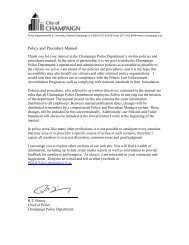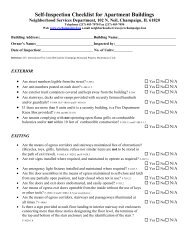2010-2014 Consolidated Plan - City of Champaign
2010-2014 Consolidated Plan - City of Champaign
2010-2014 Consolidated Plan - City of Champaign
Create successful ePaper yourself
Turn your PDF publications into a flip-book with our unique Google optimized e-Paper software.
licensed day care facility, nursery school, or day care facility. The Childhood Lead Poisoning SurveillanceReport provides information by county on the number <strong>of</strong> children screened and identified with leadpoisoning. Of 15,229 <strong>Champaign</strong> County children aged 6 and under, 1,997 were tested in 2007. Twelvecases had 10-14 micrograms per deciliter, two cases had 15-19 micrograms per deciliter, and three caseshad a lead blood level <strong>of</strong> 20-24 micrograms per deciliter. At 10 micrograms per deciliter or higher, a childis considered to be lead poisoned in the State <strong>of</strong> Illinois and must be followed up by a venous blood testto confirm lead levels. Nursing intervention is established to educate the family on proper diet, hygiene,and cleaning methods to reduce blood lead levels.At 20 micrograms or higher, a child may begin to display some degree <strong>of</strong> developmental delay. Whenthe amount <strong>of</strong> lead in a child’s blood reaches 25 micrograms per deciliter, the local Public HealthDepartment is contacted to test for lead in the child’s home. Although the state collects data on theblood tests, the local county tests and collects data on the presence <strong>of</strong> lead in the home. If sufficientlead is found to be present in the child’s home environment, Public Health will recommend methods toremove the hazard or help to relocate the family if necessary.According to the <strong>Champaign</strong>-Urbana Public Health District, many children never get tested because theyare not in licensed daycare or do not attend kindergarten. In addition, Public Health believes that ifchildren were required to be tested at a younger age, many developmental disabilities that occur latercould be prevented. The data indicates a relatively few number <strong>of</strong> children (13%) were tested in the <strong>City</strong>during 2007.Lead poisoning is one <strong>of</strong> the most common and preventable childhood health hazards today. Researchindicates that even a low level <strong>of</strong> lead in a child’s blood can have harmful effects on their physical anddevelopmental health. These effects include but are not limited to:• Decreased growth• Learning problems• Impaired hearing• Behavior problems (such as hyperactivity)• Nerve and/or brain damageChildren are more susceptible to the effects <strong>of</strong> lead because their growing bodies can readily absorb it.In addition, their brains and nervous systems are more sensitive to the damaging effects <strong>of</strong> lead. Youngchildren <strong>of</strong>ten put their hands and other objects in their mouths, which is how lead dust is generallytransmitted into a child’s system. Most children do not have any symptoms, even if a blood test showsthat they have an elevated blood lead level. If a child does have symptoms, the symptoms may bemistaken for the flu or other illnesses. If symptoms do occur, they might include:• Stomach ache and cramps• Irritability• Fatigue• Frequent vomiting• Constipation• Headache• Sleep disorders• Poor appetiteLead can cause severe damage in young children. It attacks the central nervous system and theneurological system, causing brain damage, IQ reduction, learning disabilities, decreased attention span,hyperactivity, comas, seizures, and in some cases, death. There may also be significant adverse effectsto fetuses through prenatal exposure.50 Needs Assessment: Housing and Homelessness

















